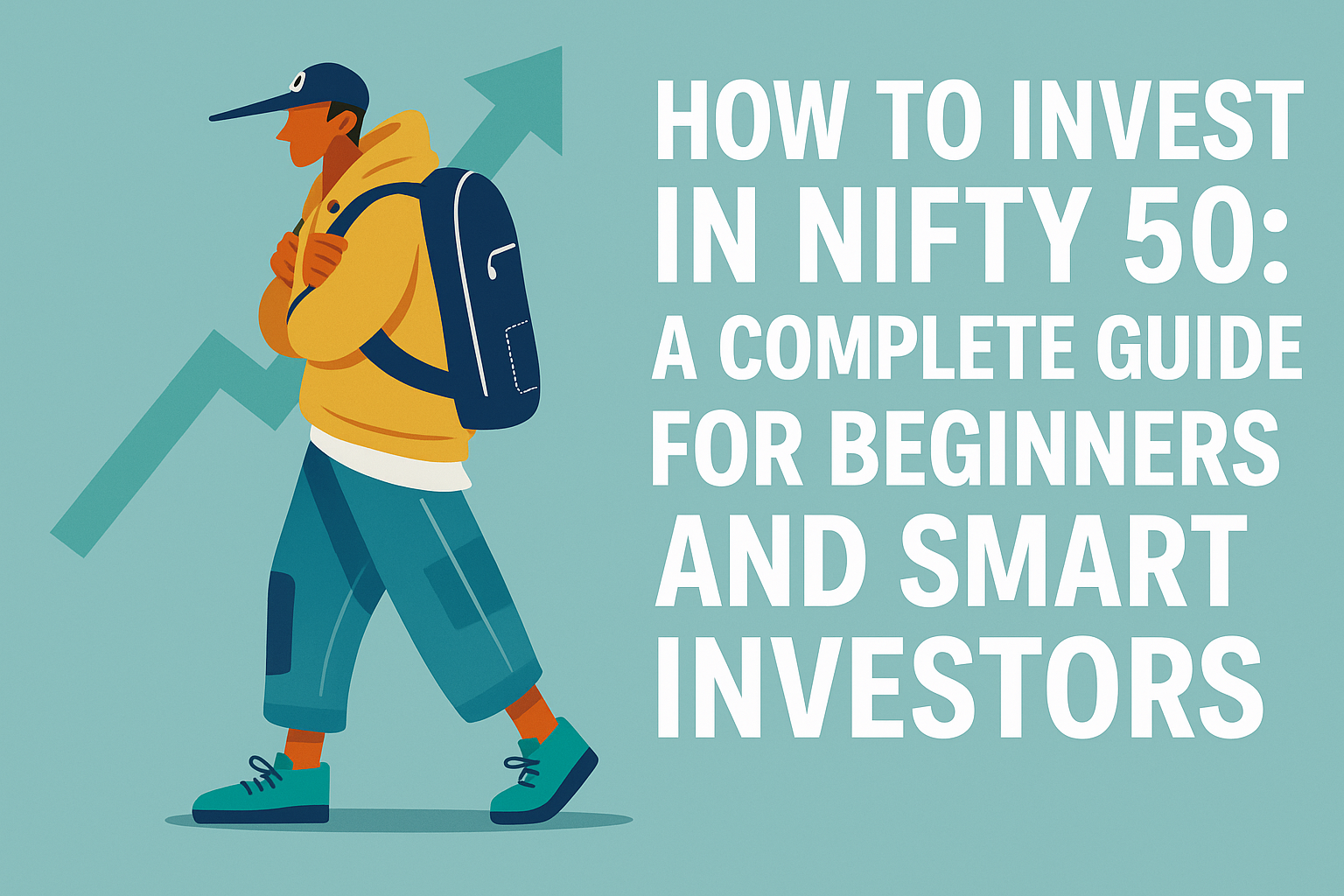Table of Contents
Investing in the stock market can seem overwhelming, especially when you’re just starting out. But if there’s one term you’ve probably heard over and over again, it’s Nifty 50. And if you’re wondering how to invest in Nifty 50, this blog will guide you through the entire process—from understanding what it is, to actionable strategies, platforms, and even personal experiences to help you get started.
What is Nifty 50 and Why It Matters
Before diving into how to invest in Nifty 50, you need to understand what it really is. Nifty 50 is a stock market index representing 50 of the largest and most liquid Indian companies listed on the National Stock Exchange (NSE). These companies span 14 different sectors, making it a diversified, benchmark index that reflects the overall performance of the Indian economy.
Unlike individual stocks that can be volatile, Nifty 50 offers a balanced exposure to multiple sectors—banking, IT, energy, FMCG, pharma, and more. It includes companies like Reliance Industries, Infosys, TCS, HDFC Bank, and ICICI Bank—names that are household terms in India.
Fact Check: According to NSE India’s data, Nifty 50 has delivered a compounded annual growth rate (CAGR) of over 12% in the past 10 years, outperforming many actively managed mutual funds. (Source)
Why Learn How to Invest in Nifty 50?

Let’s be honest. If you’re not from a finance background, terms like “index investing” or “passive strategy” can feel like financial jargon. But learning how to invest in Nifty 50 is the most beginner-friendly way to get started in the stock market. It doesn’t require you to pick individual stocks or time the market. You’re simply putting your money into an index that already represents the top 50 companies.
Personally, when I started investing, I was overwhelmed by recommendations—buy this stock, sell that one. But when I stumbled across Nifty 50 index funds, things became simpler. I didn’t have to guess anymore. I could invest in India’s economic future as a whole.
Option 1: Invest through Nifty 50 Index Mutual Funds
The most common way to learn how to invest in Nifty 50 is through index mutual funds. These funds are designed to replicate the performance of the Nifty 50 by holding all 50 companies in the same weight as the index.
Case Study: I started my journey with UTI Nifty Index Fund via monthly SIPs (Systematic Investment Plans). In three years, I saw a return of around 15% CAGR. No market timing, no stress.
Other popular Nifty 50 index funds include:
- HDFC Index Fund – Nifty 50 Plan
- ICICI Prudential Nifty Index Fund
- SBI Nifty Index Fund
- Nippon India Index Fund
Pros:
- Low expense ratio
- Diversification
- Passive, stress-free investing
Cons:
- Slight tracking error compared to the actual index
- No outperformance—just mirrors the market
Option 2: Invest in Nifty 50 ETFs (Exchange-Traded Funds)
If you’re more comfortable with stock trading platforms, the next way how to invest in Nifty 50 is via ETFs. These are listed on the NSE and BSE like regular stocks and track the Nifty 50 index.
Popular Nifty 50 ETFs include:
You can buy these ETFs through any broker like Zerodha, Groww, Upstox, or Angel One.
Why ETFs?
- Lower cost compared to mutual funds
- Real-time buying and selling
- Higher liquidity
I once used the Groww app to buy the Nippon Nifty BeES ETF and found the process as simple as buying any stock. The advantage? I didn’t need to wait for end-of-day NAV calculations like mutual funds.
Option 3: Directly Track and Mirror the Nifty 50 Portfolio
This is a bit advanced, but it’s worth mentioning for those who want full control. One way how to invest in Nifty 50 is by manually buying shares of all 50 companies in the same proportion as the index. This method is known as replicating the index.
Note: It requires significant capital (₹2-5 lakhs minimum) and regular rebalancing to match changes in the index.
Who should consider this?
- Investors with large portfolios
- DIY investors who enjoy managing their funds
- People avoiding fund manager fees
Tools to help:
- NSE Website Constituents
- Screener.in for company fundamentals
- TickerTape for tracking weights
While I haven’t personally followed this method, a friend of mine did it during the 2020 market crash. He bought all 50 stocks manually and made over 35% in a year. But he also had to rebalance every few months, which isn’t everyone’s cup of tea.
How Much Should You Invest in Nifty 50?
There’s no universal rule, but a common strategy in how to invest in Nifty 50 is to allocate 20–40% of your equity portfolio into it, depending on your risk profile.
- Beginners: Start with 30% in Nifty 50 Index Funds
- Experienced investors: Use ETFs for tactical buying
- High-net-worth individuals: Consider partial replication for tax efficiency
You can use ET Money or Kuvera to set up your SIPs and track performance over time.
Tax Implications When You Invest in Nifty 50
Understanding taxes is just as important as learning how to invest in Nifty 50. The way your profits are taxed depends on whether you’ve invested through mutual funds, ETFs, or by buying the stocks directly.
1. For Index Mutual Funds
When you invest in Nifty 50 through mutual funds:
- Short-Term Capital Gains (STCG): If you sell within 1 year, your gains are taxed at 15%.
- Long-Term Capital Gains (LTCG): After 1 year, gains above ₹1 lakh are taxed at 10% (without indexation).
2. For ETFs
Taxation is the same as equity mutual funds. However, because you can trade ETFs anytime, you might be tempted to sell early. Always keep in mind your holding period to avoid paying high STCG taxes.
3. For Direct Stock Investment
If you replicate the Nifty 50 portfolio by buying all stocks manually, each stock you sell is taxed individually as per the same STCG/LTCG rules. This creates complexity at tax filing time.
Tip: Use platforms like ClearTax or Quicko to track and file your capital gains easily.
Common Myths About How to Invest in Nifty 50
Myth 1: You Need a Lot of Money
Reality: Many believe you need ₹1 lakh or more to invest in the Nifty 50. But with mutual funds and ETFs, you can start with just ₹100 via SIPs.
Myth 2: It’s Only for Beginners
Reality: While Nifty 50 is perfect for beginners, even experienced investors use it to diversify risk and add market stability to their portfolio.
Myth 3: Active Funds Always Perform Better
Reality: According to a SPIVA report, more than 85% of active fund managers in India underperform the index over a 5-year period. That’s why knowing how to invest in Nifty 50 with a passive mindset can often be more rewarding long term.
Author’s Note: When I compared my Nifty 50 index fund’s 5-year CAGR to my friend’s actively managed fund, mine was 14.2% while his was 11.6% after fees.
When Should You Avoid Nifty 50 Investments?
Learning how to invest in Nifty 50 also includes knowing when not to invest.
- Market at All-Time Highs? It doesn’t mean you shouldn’t invest—but avoid lump sums. Use SIPs or STPs (Systematic Transfer Plans) to average your entry.
- You Need Money in 1–2 Years? Then Nifty 50 isn’t ideal. Equity markets are volatile. Stick to debt or fixed-income instruments if your time horizon is short.
- You Expect Overnight Riches? Nifty 50 is not a crypto coin or penny stock. It won’t double your money in a month. It’s a wealth creation vehicle, not a lottery ticket.
Real Story: One of my cousins invested ₹50,000 in Nifty ETF during the COVID-19 dip in March 2020. By March 2021, it was worth ₹72,000. But when the market corrected, he panicked and exited at ₹68,000. If he had stayed till 2023, it would’ve crossed ₹1 lakh.
How to Invest in Nifty 50 Consistently (Even When You’re Busy)
Many people learn how to invest in Nifty 50 but fail to stick with it consistently. The secret is automation.
1. Use SIPs or Auto-Invest Tools
Apps like Zerodha Coin, Groww, Paytm Money, and Kuvera offer features to automate your Nifty 50 investments.
2. Set a Fixed Day
Choose a fixed date—say, the 5th of every month. Treat it like a monthly EMI, but instead of paying for a car or a phone, you’re investing in India’s top 50 companies.
3. Set Goals (Don’t Just Chase Returns)
Decide why you’re investing: Retirement? House? Education? This gives your investment purpose and keeps you focused through market ups and downs.
Passive vs Active Investing: My Honest Commentary
When learning how to invest in Nifty 50, you’ll often hear about the passive vs active debate. Here’s my take after 5 years in the market:
- Passive Investing (like Nifty 50 index funds) is boring but effective. You don’t have to watch the news or follow stock tips.
- Active Investing gives you control but demands time, analysis, and discipline. And if you’re not consistent, you’ll underperform the market.
I’ve tried both. Over 3 years, my actively managed portfolio gave 9.5% returns while my Nifty 50 fund gave me 13.8%. Less stress, more returns.
Expert View: Legendary investor Jack Bogle, founder of Vanguard, once said: “Don’t look for the needle in the haystack. Just buy the haystack.” That haystack, for Indian investors, is the Nifty 50.
Tools to Track Your Nifty 50 Investments
If you want to keep tabs on your returns, check portfolio insights, and rebalance when needed, these tools are great:
- ET Money – Mutual fund tracking and SIP management
- INDmoney – Portfolio tracker and goals-based investing
- Tickertape – Index insights and stock fundamentals
- MoneyControl – News, NAV, and market updates
- TradingView – Real-time Nifty 50 chart analysis
What Happens if Nifty 50 Falls?
Let’s face it—markets crash. If you’ve learned how to invest in Nifty 50, you also need to learn how to stay calm when things go red.
Here’s the truth:
- In 2008, Nifty 50 fell over 50%. But it recovered in 2–3 years.
- In 2020, Nifty crashed 38% due to COVID-19. It bounced back within 10 months.
- Volatility is temporary. Growth is long term.
Lesson from My Life: I started investing during a bull market and panicked during my first correction. I almost sold everything. But when I held on and continued my SIPs, I saw growth again. The key is to trust the process.
Frequently Asked Questions (FAQ)
1. Is Nifty 50 safe for beginners?
Yes, Nifty 50 is one of the safest options for beginners because it includes India’s top 50 companies. It offers diversification, lower volatility compared to individual stocks, and long-term growth potential.
2. How can I invest in Nifty 50 with just ₹500?
You can start a SIP in any Nifty 50 index mutual fund using apps like Groww, Zerodha Coin, or Paytm Money with as little as ₹100–₹500 per month.
3. Can I lose money if I invest in Nifty 50?
Yes, in the short term. Stock markets are volatile. But historically, over any 10+ year period, Nifty 50 has delivered consistent positive returns. It’s a long-term wealth creation tool, not a quick-money scheme.
4. Which is better: Nifty 50 Index Fund or ETF?
Both are great. Index funds are easier for SIPs and don’t need a trading account. ETFs offer real-time buying/selling and lower costs but require a demat account. If you’re new, start with index funds.
5. How do I know if my fund is tracking Nifty 50?
Check the fund name and its benchmark on the mutual fund’s official website. You’ll see “Nifty 50” mentioned clearly. Also, the fund fact sheet includes tracking error—lower is better.
6. What is the minimum amount to start investing in Nifty 50?
- Mutual Fund: As low as ₹100
- ETF: Depends on the current market price (typically ₹180–₹220 per unit)
7. Should I invest a lump sum or SIP in Nifty 50?
SIPs are better for most investors as they average out market highs and lows. Lump sum is suitable during market corrections or when you have idle cash.
8. How long should I stay invested?
Ideally, 5 to 10 years minimum. The longer you stay, the better compounding works. Nifty 50 isn’t for short-term gains.
9. Which platforms are best for investing?
10. Does Nifty 50 give dividends?
Yes, the individual companies in Nifty 50 may declare dividends. But index funds or ETFs usually reinvest those or give you a small dividend payout. For long-term investors, this isn’t the main focus.
Final Recap: How to Invest in Nifty 50 in Simple Steps
If you’ve read this far, you already have a solid understanding of how to invest in Nifty 50. Let’s simplify it:
- Understand what Nifty 50 is
- A benchmark index of top 50 Indian companies.
- Choose your investment type
- Mutual Fund (best for beginners)
- ETF (for active investors)
- Manual stock buying (advanced)
- Pick your platform
- Mutual Fund: Groww, ET Money, Kuvera
- ETF: Zerodha, Angel One, Upstox
- Start with a SIP
- Even ₹100/month is enough to start
- Track your returns
- Use tools like INDmoney or Tickertape
- Stay invested long term
- Ignore short-term noise. Let compounding work.
- Don’t panic during corrections
- History shows recovery always follows.
A Personal Note From the Author
When I started investing, I wasted a lot of time chasing hot tips, random YouTube advice, and risky penny stocks. Some paid off, many didn’t. But the one investment that consistently gave me peace of mind and stable returns?
It was my SIP in a Nifty 50 index fund.
I didn’t need to predict the market. I didn’t need to track dozens of stocks. I just needed to be consistent.
That’s the beauty of learning how to invest in Nifty 50. It’s not just about making money—it’s about building a habit, a system, a safety net for your future.
Start Today, Not Someday
Still wondering how to invest in Nifty 50? Here’s the truth:
The best time to invest was yesterday.
The second-best time? Today.
Don’t wait for the perfect market condition. Don’t overthink. Start small. Be consistent. And let India’s top 50 companies grow your wealth while you sleep.
Whether you’re a student, working professional, or entrepreneur—Nifty 50 is for you. It’s simple, proven, and powerful.
So go ahead. Open your app. Click “Invest.” And take your first step toward financial freedom.
The Bigger Picture: How Nifty 50 Reflects India’s Growth
When you’re learning how to invest in Nifty 50, it helps to see it not just as a stock index, but as a mirror of India’s economy. Every company in the index contributes to vital sectors like finance, technology, pharmaceuticals, and energy. So when you invest in Nifty 50, you’re betting on the future of India.
For example, during the COVID-19 crisis, Nifty 50 saw a massive dip. But sectors like pharma (Sun Pharma), IT (Infosys), and FMCG (HUL) stabilized it and drove recovery.
Why That Matters to You
If you’re planning to build wealth steadily—without constant monitoring and speculation—investing in Nifty 50 is one of the most economically sound decisions you can make.
A 2023 analysis from Morningstar India found that investors who held Nifty 50 index funds for 10 years or more had a 95% chance of outperforming active fund managers in the same period.
Case Study: Three Types of Nifty 50 Investors
Let’s look at 3 real-world examples of people who applied how to invest in Nifty 50 in different ways:
1. Riya, 23 – Beginner with ₹500 SIP
Riya is a student who started investing just ₹500 per month in the ICICI Nifty Index Fund via Zerodha Coin. After 2 years, she saw a total return of 21%, despite market volatility.
Lesson: Small, consistent investments work better than big, irregular ones.
2. Aman, 35 – Corporate Employee Using ETFs
Aman started investing in Nippon Nifty BeES ETF every month, directly through his demat account. He chose ETFs to avoid mutual fund fees and maintain flexibility. In just 4 years, his portfolio crossed ₹6.2 lakh, starting from a ₹1 lakh base.
Lesson: ETFs offer real-time control and work great for salaried investors.
3. Sudhir, 45 – Manual Index Replicator
Sudhir manually replicated the Nifty 50 by purchasing all 50 stocks in proportion. He updates his portfolio quarterly using NSE data. Though complex, he claims the tax optimization and custom control have helped him save ₹45,000+ annually in capital gains taxes.
Lesson: If you have time, capital, and discipline, index replication can offer high control and low tax burden.
The Psychology Behind Long-Term Investing
One of the least discussed but most important parts of how to invest in Nifty 50 is investor psychology. Most people lose money not because of bad investments—but due to bad emotions.
1. Fear During Market Crashes
Markets fall, and people panic-sell. But those who stayed invested during the 2008 crash, 2013 taper tantrum, and 2020 COVID dip all made big returns later.
2. Greed During Bull Runs
During a bull market, some investors abandon Nifty 50 and chase multi-bagger small caps. Many regret it later when volatility hits.
3. Boredom with Passive Investing
A lot of people exit Nifty 50 funds because they don’t feel “excited.” There’s no thrill. But that’s exactly why it works.
“The stock market is a device for transferring money from the impatient to the patient.”
— Warren Buffett
Strategic Tips for Better Nifty 50 Returns
Now that you’ve understood how to invest in Nifty 50, here are smart tweaks to optimize returns:
1. Use STP During Market Highs
When markets are overheated, park money in a liquid fund and set up a Systematic Transfer Plan into Nifty 50 index funds over 6–12 months. This avoids lump sum risk.
2. Combine Nifty 50 With Nifty Next 50
Many experts recommend 80% in Nifty 50 and 20% in Nifty Next 50 for balanced growth. Nifty Next 50 often contains future Nifty 50 leaders.
3. Rebalance Once a Year
Check your allocation annually. If Nifty 50 has grown more than your target, rebalance by investing more in underperforming sectors like debt or gold.
4. Automate Everything
Don’t rely on memory. Automate SIPs, get reminders for rebalancing, and use portfolio tracking apps like INDmoney or ET Money.
The Best Time to Exit a Nifty 50 Investment
We’ve talked a lot about entering. But here’s a key part of how to invest in Nifty 50—knowing when to exit:
- Don’t exit during market corrections unless you need money.
- Exit slowly near your financial goal. Example: If you’re saving for a house in 2027, start shifting from equity to debt by 2026.
- Exit fully if your risk profile changes drastically (health issues, emergency fund needs, etc.)
Don’t time the market. Time in the market beats timing it.
Investing in Nifty 50 Is Like Planting a Tree
Let’s end with a simple metaphor.
Investing in Nifty 50 is like planting a tree.
You don’t dig it up every week to check the roots.
You water it, protect it, and give it time.
Eventually, it provides shade, shelter, and fruits.
You now have everything you need—from platforms and strategies to psychology and case studies. Stop waiting for the “perfect” moment. Start with whatever amount you can. Invest in Nifty 50. Stay the course.
Because in the long run, it’s not timing the market that builds wealth—it’s time in the market.




Leave a Reply